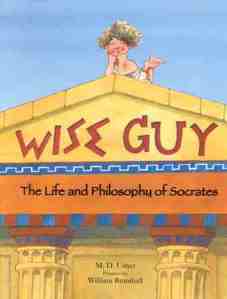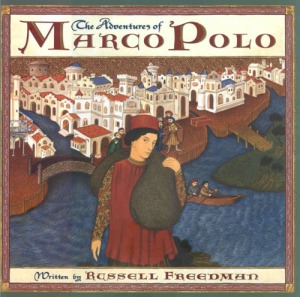 Wise Guy is one of the more unusual children’s books I’ve ever run across. The illustrations and narrative are written for young people aged 8-12, but there is a deceptive depth to this book that will delight older students as well as helping the occasional adult who is reading it out loud (or to themselves). Along with the engaging illustrations – which make life in ancient Athens look quite pleasant there is a second boxed narrative in smaller type which complements the larger font story. These smaller boxed notes give a little deeper and fuller account of the ideas presented in the pictures. One of the unusual features of the book is that is based entirely on the ancient sources from classical Greece. We get a nuanced introduction to Socrates personality as well as the key ideas and outline of his thought on knowledge and ethics, as well as his attitude towards the Greek gods and mythology. His skepticism about the gods is, of course, what led to his trial and execution, presented (without being morbid or maudlin) on the last two pages of the book. The final two-page spread is a delightful caricatured rendition of Raphael’s School of Athens, with Socrates and a host of modern thinkers whom he influenced arrayed on the steps around him. Most younger readers won’t recognize them at first, but adults and older students will enjoy seeing the connections that are made. Wise Guy is a hardback, 32 pages, 9″ x 11″ color on glossy stock. $16.00 directly from Greenleaf Press.
Wise Guy is one of the more unusual children’s books I’ve ever run across. The illustrations and narrative are written for young people aged 8-12, but there is a deceptive depth to this book that will delight older students as well as helping the occasional adult who is reading it out loud (or to themselves). Along with the engaging illustrations – which make life in ancient Athens look quite pleasant there is a second boxed narrative in smaller type which complements the larger font story. These smaller boxed notes give a little deeper and fuller account of the ideas presented in the pictures. One of the unusual features of the book is that is based entirely on the ancient sources from classical Greece. We get a nuanced introduction to Socrates personality as well as the key ideas and outline of his thought on knowledge and ethics, as well as his attitude towards the Greek gods and mythology. His skepticism about the gods is, of course, what led to his trial and execution, presented (without being morbid or maudlin) on the last two pages of the book. The final two-page spread is a delightful caricatured rendition of Raphael’s School of Athens, with Socrates and a host of modern thinkers whom he influenced arrayed on the steps around him. Most younger readers won’t recognize them at first, but adults and older students will enjoy seeing the connections that are made. Wise Guy is a hardback, 32 pages, 9″ x 11″ color on glossy stock. $16.00 directly from Greenleaf Press.
 The Adventures of Marco Polo by Russell Freedman is a well-written, carefully balanced assessment of one of the most controversial writers from the Middle Ages. Marco Polo’s tales were so outlandish that they were dismissed by many at the time (and by many still today) as wildly exaggerated or even fabricated. For example, he said he had seen rocks that burned – a fantastic tale that Europeans dismissed. Of course, what he had seen was coal – which was plentiful in China, but virtually unknown in Europe in the Middle Ages. Still many of his claims remain unsubstantiated. Marco (and his cousin and his uncle) spent twenty-four years in China, learning the language, making a living as merchants, and winning the favor and confidence of The Mongol Emperor, Kublai Khan ( a descendant of Ghenghis Khan). Freedman does an excellent job of describing their journey, and the remarkable adventures they had while in China. And Freedman includes a page-long discussion of the influence that Marco Polo had on a later explorer, Christopher Columbus. Here is what Freedman has to say: “Marco’s book seems to have fired the imagination of Christopher Columbus. He used his well-thumbed Latin translation as a guidebook, scribbling notes in the margins and underlining passages about gold, jewels, and spices, when he sailed west across the Atlantic, expecting to rediscover the land described by Marco Polo. When Columbus reached Cuba, he believed that he was at the edge of the Great Khan’s realm and would soon find the Mongol kingdom of Cathay.” Freedman’s forte is young adult biography. He has twice had books finish as finalists for the Newbery Medal (The Wright Brothers and Eleanor Roosevelt) and in 1988 won the Newbery Medal itself for Lincoln: A Photobiography. He and his publisher do not neglect the visual in this book either. The full-page chapter-heading paintings by Russian painter Bagram Ibatoulline are stunning. Ibatoulline is able to adapt his style in masterful fashion as he moves from medieval illumination to Chinese silk painting. Also included in the text are dozens of archival illustrations which appeared in the numerous hand-written copies of Marco Polo’s book that circulated in the century before printing. The Adventures of Marco Polo is a hardback, 64 pages, 10″ by 10″. The text junior high to high school and adult. $17.99 direct from Greenleaf Press.
The Adventures of Marco Polo by Russell Freedman is a well-written, carefully balanced assessment of one of the most controversial writers from the Middle Ages. Marco Polo’s tales were so outlandish that they were dismissed by many at the time (and by many still today) as wildly exaggerated or even fabricated. For example, he said he had seen rocks that burned – a fantastic tale that Europeans dismissed. Of course, what he had seen was coal – which was plentiful in China, but virtually unknown in Europe in the Middle Ages. Still many of his claims remain unsubstantiated. Marco (and his cousin and his uncle) spent twenty-four years in China, learning the language, making a living as merchants, and winning the favor and confidence of The Mongol Emperor, Kublai Khan ( a descendant of Ghenghis Khan). Freedman does an excellent job of describing their journey, and the remarkable adventures they had while in China. And Freedman includes a page-long discussion of the influence that Marco Polo had on a later explorer, Christopher Columbus. Here is what Freedman has to say: “Marco’s book seems to have fired the imagination of Christopher Columbus. He used his well-thumbed Latin translation as a guidebook, scribbling notes in the margins and underlining passages about gold, jewels, and spices, when he sailed west across the Atlantic, expecting to rediscover the land described by Marco Polo. When Columbus reached Cuba, he believed that he was at the edge of the Great Khan’s realm and would soon find the Mongol kingdom of Cathay.” Freedman’s forte is young adult biography. He has twice had books finish as finalists for the Newbery Medal (The Wright Brothers and Eleanor Roosevelt) and in 1988 won the Newbery Medal itself for Lincoln: A Photobiography. He and his publisher do not neglect the visual in this book either. The full-page chapter-heading paintings by Russian painter Bagram Ibatoulline are stunning. Ibatoulline is able to adapt his style in masterful fashion as he moves from medieval illumination to Chinese silk painting. Also included in the text are dozens of archival illustrations which appeared in the numerous hand-written copies of Marco Polo’s book that circulated in the century before printing. The Adventures of Marco Polo is a hardback, 64 pages, 10″ by 10″. The text junior high to high school and adult. $17.99 direct from Greenleaf Press.
– Rob Shearer
Director, Schaeffer Study Center
Publisher, Greenleaf Press